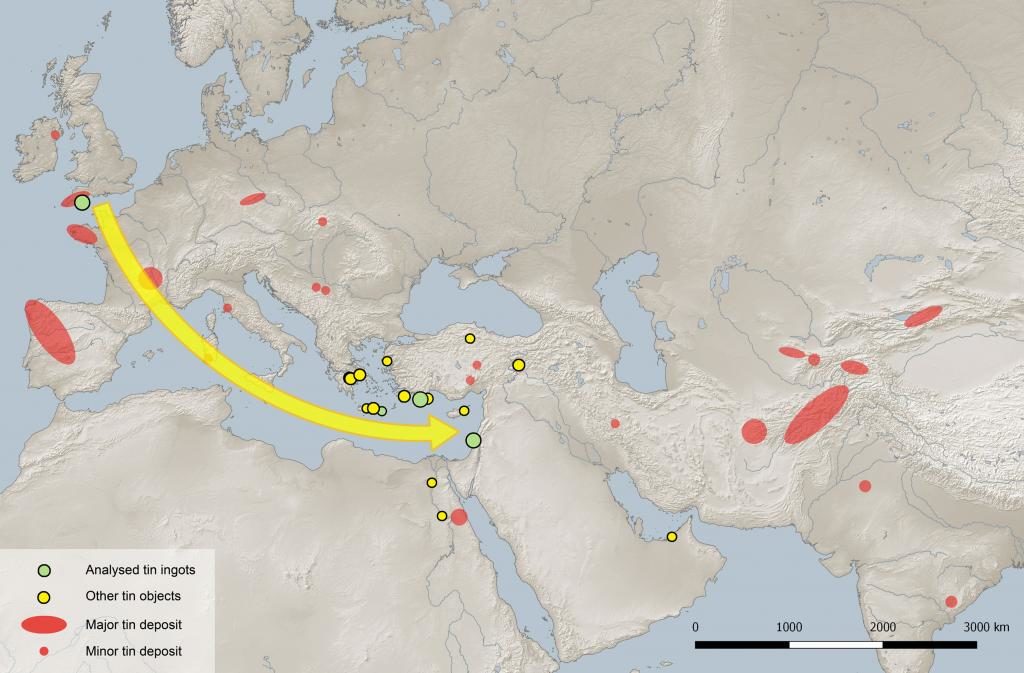The origin of the tin used in the Bronze Age has long been one of the greatest enigmas in archaeological research. Now researchers from Heidelberg University and the Curt Engelhorn Centre for Archaeometry in Mannheim have solved part of the puzzle. Using methods of the natural sciences, they examined the tin from the second millennium BCE found at archaeological sites in Israel, Turkey, and Greece.
They were able to proof that this tin in form of ingots does not come from Central Asia, as previously assumed, but from tin deposits in Europe. The findings are proof that even in the Bronze Age complex and far-reaching trade routes must have existed between Europe and the Eastern Mediterranean. Highly appreciated raw materials like tin as well as amber, glass, and copper were the driving forces of this early international trade network.

© Berger et al. 2019t | Prepared by Daniel BergerTin deposits on the Eurasian continent and distribution of tin finds in the area studied dating from 2500–1000 BCE. The arrow does not indicate the actual trade route but merely illustrates the assumed origin of the Israeli tin based on the data.
Bronze, an alloy of copper and tin, was already being produced in the Middle East, Anatolia, and the Aegean in the late fourth and third millennia BCE. Knowledge on its production spread quickly across wide swaths of the Old World. "Bronze was used to make weapons, jewellery, and all types of daily objects, justifiably bequeathing its name to an entire epoch. The origin of tin has long been an enigma in archaeological research", explains Prof. Dr Ernst Pernicka, who until his retirement worked at both the Institute for Earth Sciences of Heidelberg University as well as the Curt Engelhorn Centre for Archaeometry. "Tin objects and deposits are rare in Europe and Asia. The Eastern Mediterranean region, where some of the objects we studied originated, had practically none of its own deposits. So the raw material in this region must have been imported", explained the researcher.
Metals traded in ingot form are particularly valuable for research because questions of origin can be targeted specifically. Using lead and tin isotope data as well as trace element analysis, the Heidelberg-Mannheim research team led by Prof. Pernicka and Dr Daniel Berger examined the tin ingots found in Turkey, Israel, and Greece. This allowed them to verify that this tin really did derive from tin deposits in Europe.
The tin artefacts from Israel, for example, largely match tin from Cornwall and Devon (Great Britain). "These results specifically identify the origin of tin metal for the first time and therefore give rise to new insights and questions for archaeological research", adds Dr Berger, who conducts research at the Curt Engelhorn Centre for Archaeometry.
The studies were carried out as part of the "BronzeAgeTin - Tin Isotopes and the Sources of Bronze Age Tin in the Old World" project with funding from an ERC Advanced Grant. Their findings were published in the journal
PLoS ONE.Reference:Isotope systematics and chemical composition of tin ingots from Mochlos (Crete) and other Late Bronze Age sites in the eastern Mediterranean Sea: An ultimate key to tin provenance?




Reader Comments
R.C.
The fact that these two metals come from two distant places, helps you very much, naturally.
Of course the purification process for these metals is something you know by instinct, and you know how to make a perfect mix of the two metals !
That sounds perfectly reasonable to me.
(... by the way, there are some other minor problems with achieving a high enough temperature ... - but that is trivial ... )
D.
The answer seems to me to relate to the fact that something catastrophic ended the bronze age so folks digressed on their tech levels.
R.C.
First of all, we are looking at it from our perspective ( with knowledge of metallurgy in advance, we know what we want to make - metals )
and not from the perspective of a person that does not know that metals exist much less what to do with them or how to make them.
Smelting requires a very high temperature that you can NOT have with a simple camp fire.
You simply can not stumble upon metallurgy by pure accident, so the story that we learned it on our own has to be false.
The question is - who gave us that knowledge (Prometheus ???).